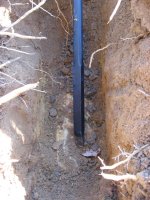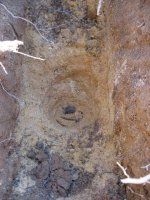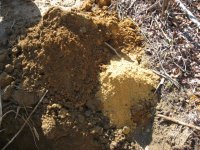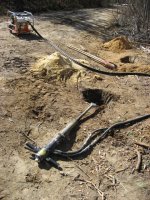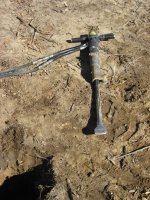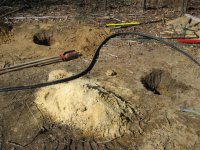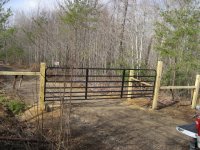You are using an out of date browser. It may not display this or other websites correctly.
You should upgrade or use an alternative browser.
You should upgrade or use an alternative browser.
Gate Post Hole Through Rock
- Thread starter Obed
- Start date
- Views: 21969
More options
Who Replied?
/ Gate Post Hole Through Rock
#21
Obed
Elite Member
Obed
Elite Member
Here you can see the the sandstone remains that I created with the digging bar. My digging turned the sandstone into sand which I removed out of the hole with the posthole diggers. Note the contrast in the the color between the light sandstone and the darker colored dirt.
Attachments
Obed
Elite Member
Obed
Elite Member
Believe me, digging this pitiful little hole was really tough work. After 20 minutes of solid digging, I only penetrated the hard sandstone about 4 inches deep and 6 inches in diameter. I need to dig almost two feet deep through this rock and 12 inches in diameter. This digging bar isn't going to work. I'll never get my gate put up using this tool.
EddieWalker
Epic Contributor
I don't think you have sandstone. It looks like just sand that's very hard packed. There are no chunks of rock in your spoils pile.
I bet that a big masonary drill bit with an extension on it will cut right through it like nothing. Then with a few dozen holes around the edge and inside of it, the bar will break it up real easy.
The secrete to breaking up rock and hard materials is to have air around it. Concrete flat on the ground is very hard to break, but if you lift it just an inch, it breaks real easy. I think the same will be true for your hole. But since you can't lift it, you can create the space with a large drill bit. One inch or larger.
If you have a helper, you can also drill into it with the digging bar. I did this on a fence line in Northern California into a type of rock. We took turns holding and swinging the sledge hammer. The holder of the digging bar rotates it just a bit after every hit. In a short amount of time it will dig a good sized hole. Then dig another hole and another hole untile they start combining. It's allot of work, but it's doable.
Eddie
I bet that a big masonary drill bit with an extension on it will cut right through it like nothing. Then with a few dozen holes around the edge and inside of it, the bar will break it up real easy.
The secrete to breaking up rock and hard materials is to have air around it. Concrete flat on the ground is very hard to break, but if you lift it just an inch, it breaks real easy. I think the same will be true for your hole. But since you can't lift it, you can create the space with a large drill bit. One inch or larger.
If you have a helper, you can also drill into it with the digging bar. I did this on a fence line in Northern California into a type of rock. We took turns holding and swinging the sledge hammer. The holder of the digging bar rotates it just a bit after every hit. In a short amount of time it will dig a good sized hole. Then dig another hole and another hole untile they start combining. It's allot of work, but it's doable.
Eddie
slowzuki
Elite Member
- Joined
- Sep 19, 2003
- Messages
- 4,156
- Location
- New Brunswick, Canada
- Tractor
- Kubota L5030 HSTC, MF 5455, Kubota M120, Allis Chalmers 7010
Bah that stuff is terrible to beat at, it soaks up your blows. The suggestion to rent a rotary hammer is good, mine is a hmm, I can't remember but it blasted 54 holes, 3/4" diameter, 12" deep into 2 year old concrete including hitting lots of rebar in about half a day. Hitting rebar we would switch to the core drill then back. The core drill was probably over half the time spent.
You could have that hole chewed out quick even with a small bit.
The other option like they said is to use the same type drill to set anchors into the material if it is tough enough to pin a slab to it.
You could have that hole chewed out quick even with a small bit.
The other option like they said is to use the same type drill to set anchors into the material if it is tough enough to pin a slab to it.
KentT
Elite Member
- Joined
- Mar 31, 2005
- Messages
- 2,928
- Location
- Sevierville, TN
- Tractor
- 1993 Power Trac 1430 w/Kubota diesel engine
Eddie,
Having lived in Utah and Colorado in addition to Obed's general area, I can confirm that he has sandstone, and not just sand. In some areas it is just compressed more, making it harder than others. Some parts will break into chunks, some will crumble like sand. Remember also that the Appalachians in the Great Smoky Mtns, across the Tennessee River valley from Obed's place, are the oldest mountains in the world. This rock (if not basalt or granite) is "rotten" as it would be called in the Southwest. Even the slate and shale in this area often crumbles. However, there's marble mining and other commercial cut stone (called "Crab Orchard" stone) that's mined not far from Obed's area also... It varies widely in a pretty small geographic area.
For example, here's a pic from my property in the foothills of the Smokies where this tiny stream has eroded down to solid rock -- sandstone and shale -- and created little cascades all down the stream. This stone is so soft that if you hit either the shale or the sandstone with a hammer, it crumbles...
http://farm1.static.flickr.com/48/139506053_67ca5aad8b.jpg?v=0
Farther downstream, below the spillway for the lake my property is on, this is what these cascades look like. Look how round and eroded this solid rock is. There's also a bit less sandstone here, and more shale. The shale is finer grain and is a bit harder -- but not a whole lot. This whole area was seabed, many, many millions of years ago, and is sedimentary. Some areas only 30-40 miles away is pure limestone, where underwater streams, caverns and artesian springs are common. Only along the spine of the Appalachians did the crust buckle, bringing granite and basalt closer to the surface. In the many millions of years since, all the sandstone, shale and softer rock has eroded off those peaks, which will now expose the granite and basalt. Alabama, Mississippi and Louisiana are likely what's left of what eroded off those mountains -- and on the other side of the watershed the same can be said for the rolling plains of North and South Carolina...
http://farm1.static.flickr.com/32/62619925_2ff7c74db6.jpg?v=0
Obed -- I think you can drill what you need to drill with a big hammer-drill and not a jackhammer. A jackhammer would just turn it into sand and pound the sand...
Having lived in Utah and Colorado in addition to Obed's general area, I can confirm that he has sandstone, and not just sand. In some areas it is just compressed more, making it harder than others. Some parts will break into chunks, some will crumble like sand. Remember also that the Appalachians in the Great Smoky Mtns, across the Tennessee River valley from Obed's place, are the oldest mountains in the world. This rock (if not basalt or granite) is "rotten" as it would be called in the Southwest. Even the slate and shale in this area often crumbles. However, there's marble mining and other commercial cut stone (called "Crab Orchard" stone) that's mined not far from Obed's area also... It varies widely in a pretty small geographic area.
For example, here's a pic from my property in the foothills of the Smokies where this tiny stream has eroded down to solid rock -- sandstone and shale -- and created little cascades all down the stream. This stone is so soft that if you hit either the shale or the sandstone with a hammer, it crumbles...
http://farm1.static.flickr.com/48/139506053_67ca5aad8b.jpg?v=0
Farther downstream, below the spillway for the lake my property is on, this is what these cascades look like. Look how round and eroded this solid rock is. There's also a bit less sandstone here, and more shale. The shale is finer grain and is a bit harder -- but not a whole lot. This whole area was seabed, many, many millions of years ago, and is sedimentary. Some areas only 30-40 miles away is pure limestone, where underwater streams, caverns and artesian springs are common. Only along the spine of the Appalachians did the crust buckle, bringing granite and basalt closer to the surface. In the many millions of years since, all the sandstone, shale and softer rock has eroded off those peaks, which will now expose the granite and basalt. Alabama, Mississippi and Louisiana are likely what's left of what eroded off those mountains -- and on the other side of the watershed the same can be said for the rolling plains of North and South Carolina...
http://farm1.static.flickr.com/32/62619925_2ff7c74db6.jpg?v=0
Obed -- I think you can drill what you need to drill with a big hammer-drill and not a jackhammer. A jackhammer would just turn it into sand and pound the sand...
Obed
Elite Member
Obed
Elite Member
KentT said:Having lived in Utah and Colorado in addition to Obed's general area, I can confirm that he has sandstone, and not just sand. ...
Obed -- I think you can drill what you need to drill with a big hammer-drill and not a jackhammer. A jackhammer would just turn it into sand and pound the sand...
KentT,
You described things just as well as if you had been here. Yes, this was sandstone, not sand. I didn't know if I could get down deep enough with a hammer drill. My holes were between 15 and 21 inches deep when I hit the base sandstone. My goal was to dig the holes 3 ft. deep. Would it be possible dig down 3 ft with a hammer drill?
However, the jackhammer did just what you said; it didn't break the rock up in chunks, it pounded it into sand. Then I dug the sand out with the hand post hole digger. Then I jacked hammered some more. It took a few hours to dig 4 holes.
Obed
gemini5362
Veteran Member
KentT said:Eddie,
Remember also that the Appalachians in the Great Smoky Mtns, across the Tennessee River valley from Obed's place, are the oldest mountains in the world. This rock (if not basalt or granite) is "rotten" as it would be called in the Southwest. Even the slate and shale in this area often crumbles. However, there's marble mining and other commercial cut stone (called "Crab Orchard" stone) that's mined not far from Obed's area also... It varies widely in a pretty small geographic area.
[ Actually I have heard the same thing said about the Ozark Mountain Range being the oldest mountain range in the world. Supposedly the Ozarks were a lot higher elevation than they are now but are so old that erosion wore them down to the height they are now.
Obed
Elite Member
Here's a picture of the jackhammer and gasoline powered hydraulic pack. I had asked the rental place if I could hook the jackhammer up to the hydraulics on my tractor and they said no. However, after picking up the equipment, I think the jackhammer might have run off of my tractor. But using the power pack was convenient because it freed the tractor up for doing other things.
Attachments
Obed
Elite Member
This picture shows the jackhammer bit that worked best. Notice the wide chisel like end. I first tried a pointed bit. The pointed bit just dug small holes straight down. The pointed bit would tend to get stuck in the hole and I'd have to kill myself to get it unstuck. Then I tried a chisel shaped bit that was the same width as the shaft of the bit. This bit worked about the same as the pointed bit. Then I tried the wide chisel shaped bit. This bit was the dullest so I was afraid it wouldn't work very well. However, this bit did the best job; I suppose that's why is was so dull; everyone else used it too.
Attachments
Obed
Elite Member
Here's a hole (on the right) after finishing digging through the rock. Look at that big pile of light colored sand. All that sand was hard solid rock. If you look closely you can see a couple small rocks that came out but that was rare. Mostly the sandstone just turned to sand.
This hole will host the gate post. I hit rock at 15 inches and then dug down with the jackhammer for a final depth of just below 3 ft. I made the bottom of the holes a little wider than the tops to help resist frost heave. Making these bell shaped holes with the jackhammer wasn't a hole lot of fun.
This hole will host the gate post. I hit rock at 15 inches and then dug down with the jackhammer for a final depth of just below 3 ft. I made the bottom of the holes a little wider than the tops to help resist frost heave. Making these bell shaped holes with the jackhammer wasn't a hole lot of fun.
Attachments
Obed
Elite Member
Here's a picture of the 4 holes with the posts set in them and the 16 ft. gate after hanging it. The posts are 6x6 treated wood. Three of the posts are 8 ft long. The gate post is 10 ft. long. Getting this gate hung was a really big accomplishment for me. I've been very concerned about how I would get the post holes deep enough to hang the gate.
I hope there's a better way to dig through this rock. The way I dug the holes worked but it was much harder and slower to do than I imagined. We called several rental stores in three counties to try to rent a rock auger but nobody had one. My wife talked to a professional fence builder in our area. He said he uses a 90 lb. jack hammer to dig his post holes through rock. So maybe our method is the best way to go around here. But I'm still not quite convinced.
Maybe the hammer drill method would work better? I might run into this issue again as I think about building a pole barn sometime down the road.
I hope there's a better way to dig through this rock. The way I dug the holes worked but it was much harder and slower to do than I imagined. We called several rental stores in three counties to try to rent a rock auger but nobody had one. My wife talked to a professional fence builder in our area. He said he uses a 90 lb. jack hammer to dig his post holes through rock. So maybe our method is the best way to go around here. But I'm still not quite convinced.
Maybe the hammer drill method would work better? I might run into this issue again as I think about building a pole barn sometime down the road.
Attachments
weldingisfun
Veteran Member
- Joined
- Dec 12, 2006
- Messages
- 1,824
- Location
- West Bell County, Texas
- Tractor
- Mahindra 4500 4WD w/FEL, and Scotts S2048 lawn tractor
Here is the solution to your rock problem. But, when you see the price you'll probably pass out so be sure you are sitting down. Go to implements and then auger system. CM Trailers available at Kempner Equipment, Inc.. Your home for Utility Equipment Trailers, Gooseneck Dump Trailers, flatbed utility trailers, heavy duty gooseneck trailers, Auto Transport Trailers, livestock trailers, horse trailers, hydraulic dump trailers, heavy equipment utility trailers, Hay trailers, cargo trailers and all of your utility trailer needs. Used Trailers available. We also stock farm implements and accessories.
I've seen these things work in solid limestone. They do the job.
I've seen these things work in solid limestone. They do the job.
KentT
Elite Member
- Joined
- Mar 31, 2005
- Messages
- 2,928
- Location
- Sevierville, TN
- Tractor
- 1993 Power Trac 1430 w/Kubota diesel engine
gemini5362 said:KentT said:Eddie,
Remember also that the Appalachians in the Great Smoky Mtns, across the Tennessee River valley from Obed's place, are the oldest mountains in the world. This rock (if not basalt or granite) is "rotten" as it would be called in the Southwest. Even the slate and shale in this area often crumbles. However, there's marble mining and other commercial cut stone (called "Crab Orchard" stone) that's mined not far from Obed's area also... It varies widely in a pretty small geographic area.
[ Actually I have heard the same thing said about the Ozark Mountain Range being the oldest mountain range in the world. Supposedly the Ozarks were a lot higher elevation than they are now but are so old that erosion wore them down to the height they are now.
I've heard the Ozarks and the Appalachians were once the same mountain chain, as was the Blue Ridge and Black Mountains of North Carolina. Likely thousands of feet have eroded off the tops of them, in addition to rivers (such as the Mississippi or Tennessee) cutting through them. The Cumberland Plateau (where Obed lives) is very similar terrain as the parts of the Ozarks that I've visited.
Obed said:KentT,
You described things just as well as if you had been here. Yes, this was sandstone, not sand. I didn't know if I could get down deep enough with a hammer drill. My holes were between 15 and 21 inches deep when I hit the base sandstone. My goal was to dig the holes 3 ft. deep. Would it be possible dig down 3 ft with a hammer drill?
However, the jackhammer did just what you said; it didn't break the rock up in chunks, it pounded it into sand. Then I dug the sand out with the hand post hole digger. Then I jacked hammered some more. It took a few hours to dig 4 holes.
Obed
Obed, I have similar rock in some places around where my property is next to Townsend on the other side of the valley. It's usually a pale, golden yellow, but will sometimes be off-white or even a bright white.
When I built the driveway into my lot, we hauled a dozen tandem loads of fill-dirt from just a couple miles down the road, where a guy was cutting off the hillside behind his house to change the drainage. It was bright orange/red clay filled with "nodules" of white sandstone. Here's a pic of the truck dumping a load as we were installing the culvert. Though they look like clumps of clay, they're actually clumps of sandstone covered in clay. I gathered up quite a few of them to use as "rip-rap" around each end of the culvert, and to build a small catch-basin at the lower end of it. Some of those nodules would literally fall apart in my hands. I found it quite interesting that these were intermixed in the clay hillside -- and didn't run in layers or veins. It was like they were "seeds sprinked through the dirt." It's also interesting to note the contrast in the soil type -- from less than two miles away. My dirt appears to be decomposed shale and organic material and is a light yellowish-brown when the organic stuff is removed...
http://farm1.static.flickr.com/43/108509319_2669e9009b.jpg?v=1142118739
http://farm1.static.flickr.com/45/111052493_7fb8ba1c95.jpg?v=0
http://farm1.static.flickr.com/36/108514017_6179c35180.jpg?v=1142119772
As far as using a hammer-drill, I've seen holes dug in this stuff by drilling a ring of smaller, shallow holes, then using a long pry-bar to break out the soft rock between the holes. Then you repeat the process -- similar to chiseling out a mortise joint in large timbers... Don't know if it is really faster or easier than what you did, but as they say "Necessity is the mother of invention...."
Zinno87
Bronze Member
I've yet to try this roduct on my own, but it seems like it does have a lot of potential. It's more for freestanding rock, where there is room for the material to expand, but I'm curious as to whether it would have worked well enough for an application such as yours. You'd probably have to drill a few holes in the rock, pour it in and wait. After that, you might be able to get the fractured pieces of rock out, assuming they fracture, with a regular auger.
Welcome to Archer Company USA, Inc.
Welcome to Archer Company USA, Inc.
EddieWalker
Epic Contributor
Obed,
Congrats on digging your holes. Nothing better then setting a goal and achieving it!!!
Eddie
Congrats on digging your holes. Nothing better then setting a goal and achieving it!!!
Eddie

